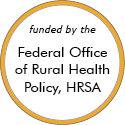Rural Project Examples: Hospitals
Other Project Examples
The Hospital Cooperative Mobile MRI
Updated/reviewed October 2024
- Need: Critical Access Hospitals in Idaho were not able to afford a fixed MRI system.
- Intervention: The hospitals partnered to purchase a mobile MRI unit to travel among facilities.
- Results: The MRI unit went into service in 2012, providing hundreds of scans per month and traveling among six member hospitals in rural Idaho.
Rural Recruitment Reimagined Workshop Presents the "Safe Sites" Model
Updated/reviewed April 2024
- Need: Strategies to recruit and retain providers to practice in rural settings.
- Intervention: A traveling one-day workshop was designed to share ideas and firsthand accounts on successful strategies on how to create "Safe Sites" for new recruits.
- Results: So far, workshops have trained over 250 hospital administrators, board members, and rural hospital recruiters.
Bozeman Health RV Parking Program
Added February 2024
- Need: To provide a convenient and affordable lodging option for patients who have traveled from a distance to receive medical treatment in Bozeman, Montana.
- Intervention: An RV parking program that lets anyone who is actively seeking care at Bozeman Health Deaconess Regional Medical Center stay in the hospital parking lot.
- Results: Throughout the summer of 2023, at least one patient was using an RV parking space at all times.
Healthy Southern Illinois Delta Network
Updated/reviewed November 2023
- Need: To improve people's health in a rural 16-county region in Illinois.
- Intervention: A coalition of local health departments and healthcare facilities coordinates regional efforts, which are implemented locally by health community coalitions.
- Results: HSIDN has created toolkits, developed resource guides, and provided wellness trainings, among other initiatives.
Jefferson Healthcare Prescription CSA
Added July 2023
- Need: To increase food security among low-income patients living with cancer and diabetes in rural Jefferson County, Washington.
- Intervention: A local healthcare system partnered with a small organic farm to offer weekly produce boxes to eligible low-income patients.
- Results: 10 patients participated in the Jefferson Healthcare prescription CSA program in 2022. In 2023, the program grew to serve 15 patients.
The Minnesota Integrative Behavioral Health Program
Updated/reviewed May 2023
- Need: Out of 79 Critical Access Hospitals (CAHs) surveyed in Minnesota in 2015, behavioral health was the most frequently cited service requested.
- Intervention: In response, Rural Health Innovations launched the Minnesota Integrative Behavioral Health Program. This initiative engaged representatives across all sectors in health integration between hospital, primary care, and community services.
- Results: Strategy sessions resulted in the creation of resource directories to improve care coordination, evaluation measurements to document results, and an overall better understanding of integrative care challenges.
Addiction Recovery Mobile Outreach Team (ARMOT)

Updated/reviewed January 2023
- Need: To reduce the number of overdoses and overdose-related deaths from opioids in rural Pennsylvania.
- Intervention: ARMOT provides 1) case management and recovery support services to individuals with substance use disorders and 2) education and support to rural hospital staff, patients, and their loved ones.
- Results: Since 2015, ARMOT has received over 2,956 referrals.
Boone County Health Center Pulmonary Rehabilitation Program
Updated/reviewed June 2022
- Need: Evidenced-based intervention to improve function and quality of life for patients with chronic obstructive pulmonary disease and other chronic lower respiratory conditions.
- Intervention: Pulmonary rehabilitation program implementation in 1989.
- Results: Compared to a national average of only about 3% of referred Medicare beneficiaries actually enrolling in pulmonary rehabilitation, 60% of the program's referred patients enroll. Averaging around 15 patients/year completing the program, a large combined cardiac and pulmonary rehabilitation maintenance population averages 8,000 visits/year.
Avita Health System Comprehensive Cardiology Program
Added April 2021
- Need: Population health approach to decreasing area deaths from cardiovascular disease.
- Intervention: A health system-level investment in level II cardiac catheterization services and the required specialized cardiology workforce.
- Results: Since August 2018, the Avita Health System in north central Ohio has provided local cardiovascular services that have decreased hospital transfers, increased care coordination, and provided education and prevention activities that, with time, will impact population health cardiovascular outcomes.
For examples from other sources, see:
